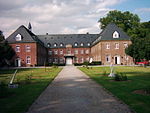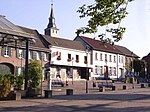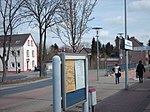Schloss Dyck
Baroque architecture in North Rhine-WestphaliaBaroque palaces in GermanyBuildings and structures in Rhein-Kreis NeussGardens in North Rhine-WestphaliaHistoric house museums in Germany ... and 4 more
Museums in North Rhine-WestphaliaPalaces in North Rhine-WestphaliaRococo architecture in GermanyWater castles in North Rhine-Westphalia

Castle Dyck (German: Schloss Dyck) is a moated castle in the Rhineland region of Germany. It is located in the municipality of Jüchen in Rhein-Kreis Neuss, North Rhine-Westphalia, between Grevenbroich and Mönchengladbach.
Excerpt from the Wikipedia article Schloss Dyck (License: CC BY-SA 3.0, Authors, Images).Schloss Dyck
Schlossbrücke,
Geographical coordinates (GPS) Address Website External links Nearby Places Show on map
Geographical coordinates (GPS)
| Latitude | Longitude |
|---|---|
| N 51.141883 ° | E 6.557306 ° |
Address
Schloss Dyck
Schlossbrücke
41363
North Rhine-Westphalia, Germany
Open on Google Maps











